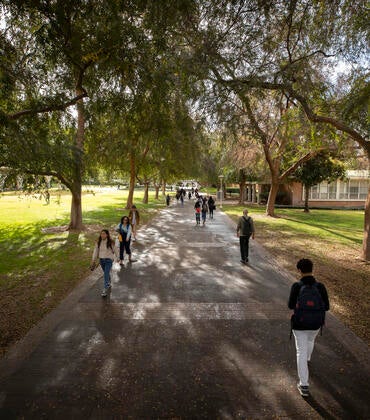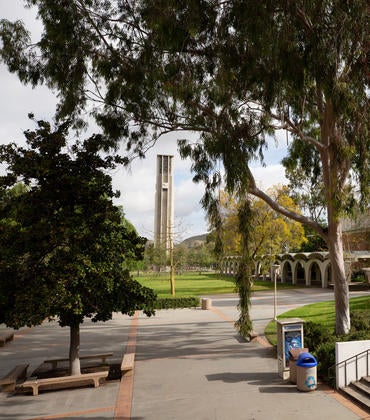The incoming freshmen class at UC Riverside – and all students across the nation – will for the first time fill out a significantly revised Free Application for Federal Student Aid, or FAFSA, form. The FAFSA Simplification Act of 2020 (https://studentaid.gov/help-center/answers/article/fafsa-simplification-act) goes into effect for the 2024-25 school year, which means the applications students and parents will submit in the coming weeks are much different – and shorter.
The major changes include that the number of FAFSA questions will be reduced from 108 to 36; the maximum Pell Grant award will increase from $6,995 to $7,395, and 75 percent of students will get more financial aid. For a family of four with one child in college, federal aid could increase by up to $3,000 per year. Another change, which acknowledges the low earnings of most students, would make families eligible for up to another $1,500 in aid per year.
Other changes: A major function of the FAFSA is to determine how much money a family can afford to pay. That has been called “Expected Family Contribution,” or EFC, but will now be called the Student Aid Index, or SAI. Despite the name change, the function is similar. Also, the “sibling discount” is gone. If a family has multiple children in college, that family will get less federal aid; potentially thousands of dollars less. Finally, the filing period opens Dec. 31, not in October, as was the case in past years.
We asked UCR Financial Aid Executive Director Jose Aguilar to help access dollars-and-cents impacts to UCR students and parents, many of whom will be impacted by these changes.
Q: A Brookings Institute analysis concluded: “FAFSA simplification may make it easier to complete the form, but its impact on college pricing is far from simple.” Do you agree?
Aguilar: Yes, I agree that the impact is far from simple. Beyond a shorter application, the benefits of expanded eligibility for the Pell Grant and federal aid for more than half of our student population are significant. In addition to concerns listed in the article, the State of California Middle-Class Scholarship, or MCS, will mitigate some of the impact for our middle-class students because it provides California resident undergraduate students with family income and assets up to $217,000 with a scholarship to attend. The MCS award eligibility is not based on the EFC, or SAI, but on the Cost of Attendance and other sources of aid the student is receiving.
Q: More federal aid will be available for low-income students. About half of UCR students are from Pell Grant-eligible families, and 87 percent receive financial aid. Does this mean – on the whole – that the FAFSA changes will benefit UCR students?
Aguilar: UCR expects to see an increase in Pell-eligible students as a result of the changes. Specifically, the new formula will be especially beneficial to single-parent households, which means our dependent students with just one parent, and our independent students who are single parents, may be eligible for more grant funding.
Q: Families with multiple students in college will get less aid, a potentially significant challenge to some families. Is it possible UCR could choose to retain the sibling discount? Will this decrease in federal aid eligibility be offset by state or institutional aid?
Aguilar: Data modeling predicts that the elimination of the number of children in college at the same time affecting eligibility for federal need-based aid will have little to no impact on our low-income families, and a larger impact on middle-income and high-income families. Prior to the formula change, the UCR Financial Aid Office has long supported continuing students who entered into college in their first year with another sibling in college, and then had to transition to a different aid package when the older sibling graduated. UCR intends to follow the new regulations, and to award every student with the maximum aid eligibility possible, while providing information and support to continuing students who experience an impact on their aid eligibility due to changes.
Q: Federal aid includes the Pell Grant, student loans (capped at $5,500 for freshmen), parent-plus loans (limited by the Cost of Attendance), and student work (up to $3,000 per academic year). What other aid can California residents apply for?
Aguilar: California residents are considered for a range of financial aid programs at UCR, which include Cal Grant, Middle Class Scholarship, California Chafee Grant, Cal Vet Fee Waiver, California Chafee Grant, USHIP grant, UCR Grant, merit awards, scholarships, Learning-Aligned Employment Program, or LAEP, Dreamer Service Incentive Grant, or DSIG, #CaliforniansForAll College Corps program, CA Dream Loan, and University Loans.
Q: What is a Cal Grant? Do other states have an equivalent of the Cal Grant, or is California unique in this regard?
Aguilar: A Cal Grant is a renewable grant offered by the California Student Aid Commission to help pay for tuition and fees. Almost every state education agency in the nation offers a state grant or scholarship available to their residents, although the amount of support offered in other states is typically far less generous when compared to the aid programs administered by the California Student Aid Commission.
Q: Does the Cal Grant influence how much federal aid a student can get, or is it factored after federal aid is determined?
Aguilar: The Cal Grant does not influence how much federal financial aid a student is offered at UCR. As families weigh the affordability of attending a particular college, they should be aware that the federal Pell Grant is the first form of aid a student with financial need can expect to receive, and that the Pell Grant is unique among other forms of aid because a student's eligibility does not vary across schools. In contrast, eligibility for a Cal Grant award does vary by the type of college. UC students, in particular, receive an enormous benefit when they qualify for a Cal Grant because their award amount is designed to cover UC systemwide tuition and fees.
Q: Processing financial aid applications is always a stressor for a campus Financial Aid office. This year, there is a much shorter filing period. What will the impacts be for UCR’s Financial Aid office, and how are you compensating for the extra workload?
Aguilar: The later application opening will have little impact on the Financial Aid Office because our awarding process for the new year typically begins in March. UCR students are more likely to be impacted by the delayed application, because they have a shorter application period. The Financial Aid office will send helpful reminder emails to all students to support them through the completion of the new simpler FAFSA application as soon as the application opens at the end of December.
Q: FAFSA applications open Dec. 31, and close April 2 in California. Does it matter when one files during that period?
Aguilar: This year, the FAFSA or California Dream Act Application and Cal Grant GPA Verification Form must be completed and filed between December 31, 2023, and April 2, 2024.
It is beneficial for all students to file a financial aid application as early as possible, and it is especially important for new students, because it allows sufficient time to receive a financial aid offer to make an informed decision before the campus asks them to commit to attending. At UC Riverside, the Statement of Intent to Register deadline is generally May 1 for entering first-year students and June 1 for transfer students. All UCR continuing students should file early to allow the Financial Aid Office to estimate their Financial Aid eligibility for attendance during the Summer Term.
Q: What are some sources where students and parents may educate themselves re. the FAFSA changes and FAFSA generally?
Aguilar: Some sources:
- FAFSA Simplification Act explainer: (https://studentaid.gov/help-center/answers/article/fafsa-simplification-act)
- Department of Education https://studentaid.gov/announcements-events/fafsa-support
- Better FAFSA - California Student Aid Commission at https://www.csac.ca.gov/post/better-fafsa#:~:text=The%20FAFSA%20Simplification%20Act%20was,students%20apply%20for%20financial%20aid.
Q: Where can families get more information re. the Cal Grant? Institutional grants? Other scholarships and grants?)
Aguilar: Information about the financial aid programs can be found on the UCR Financial aid website at financialaid.ucr.edu.
To fill out a FAFSA, visit https://studentaid.gov/. The filing period opens Dec. 31, 2023, and closes on March 2, 2024.



